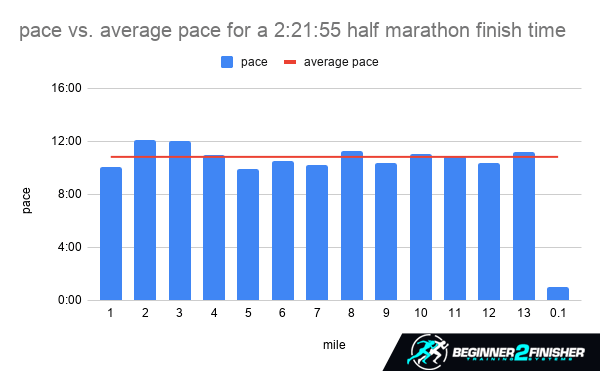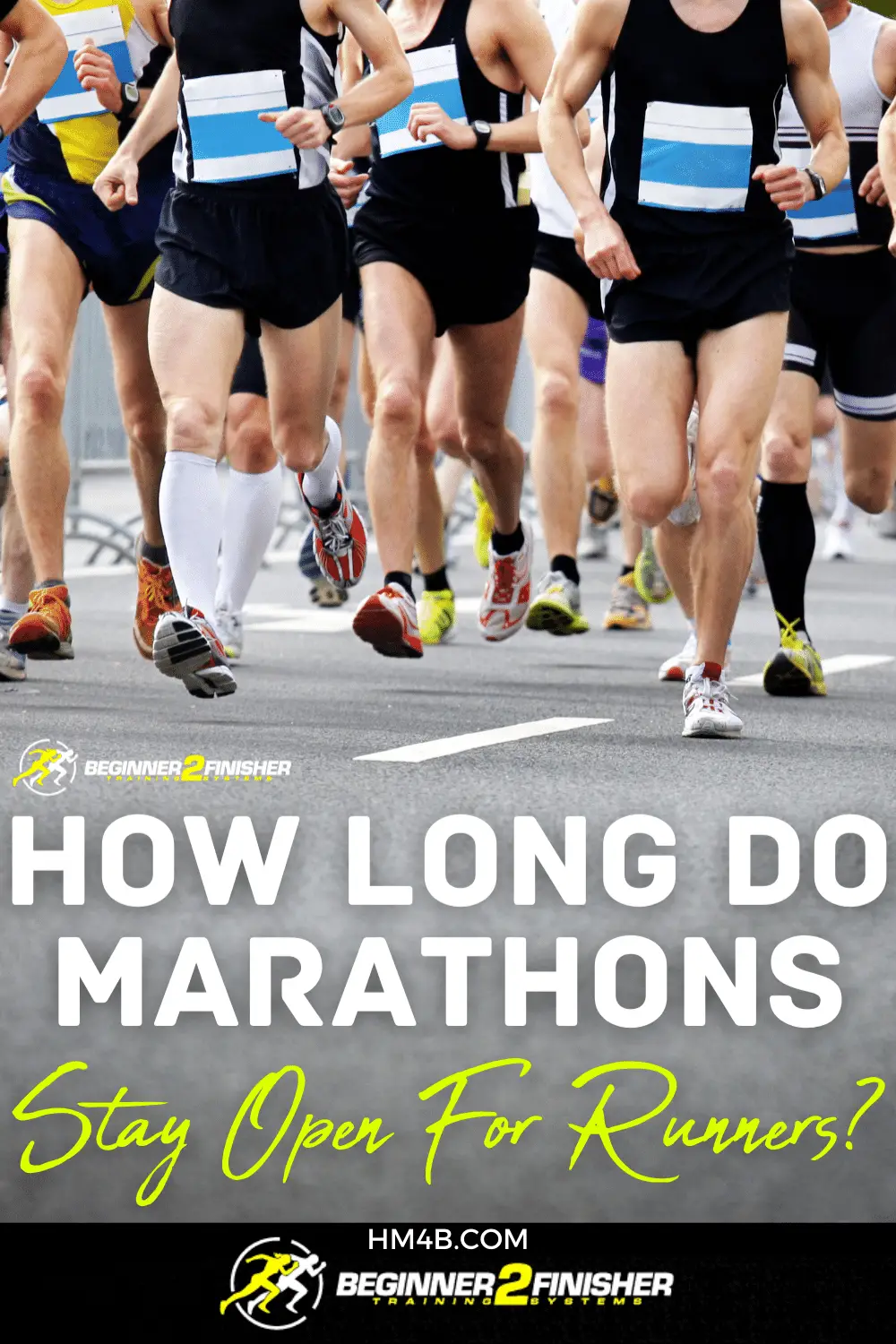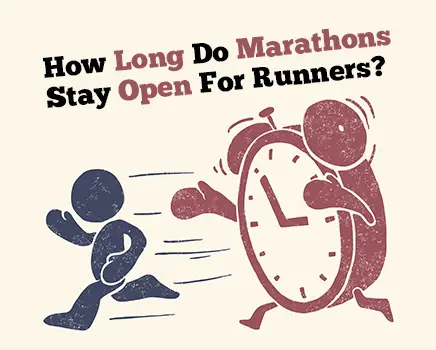So you’re about to sign up for a marathon, now what? Here comes the onslaught of questions including, how long do marathons stay open for runners? More than likely this is your first marathon and you’re wanting to know what is the slowest pace time I can have and still finish the race. Assessing the racecourse cut off times is a great place to start. One or two hours could make a huge difference in whether or not you finish before the dreaded cut-off time.
How long do Marathons Stay Open for Runners?
Marathon racecourses stay open, on average, between 6 and 7 hours. Some marathons only stay open for 5 hours, which is a rare occurrence, while a small number of marathons stay open for up to 9 hours. The slowest average pace you can run for a 7-hour marathon and still finish the race is 16:01 minutes/mile (9:57 kilometers/mile).
Marathon Cut-Off Times (Summary)
I’ve put together some simple pacing charts that show you exactly how fast you’ll need to be in order to fit in the allotted finish time.
Most Common Race Cut-Off Times (Summary)
What is an average pace and why does it matter?
Average pace is the total amount of miles/kilometers ran divided by the total time it took to run a given distance. If you take each mile and look at the individual time it took to run a given mile the time values would vary from mile to mile. Let’s look at an example:
Mary ran her last half marathon with a finish time of 2 hours and 21 minutes and 55 seconds. There are a total of 13.1 miles (21.1 kilometers) in a half marathon race. Let’s take a look at her pace based on individual miles.
| Mile | Pace | Average Pace |
|---|---|---|
| 1 | 10:03 | 10:50 |
| 2 | 12:04 | 10:50 |
| 3 | 12:03 | 10:50 |
| 4 | 11:00 | 10:50 |
| 5 | 9:55 | 10:50 |
| 6 | 10:30 | 10:50 |
| 7 | 10:15 | 10:50 |
| 8 | 11:15 | 10:50 |
| 9 | 10:22 | 10:50 |
| 10 | 11:01 | 10:50 |
| 11 | 10:55 | 10:50 |
| 12 | 10:31 | 10:50 |
| 13 | 11:10 | 10:50 |
| 0.1 | 1:00 | 10:50 |

Mary ended up with an overall average pace of 10 minutes and 50 seconds. For Mary’s first half marathon her individual pace per mile was all over the place. This type of pacing is not typical of an experienced runner. An experienced runner’s individual pace per mile will probably be much tighter and closer to the overall average pace.
Thanks to your nifty smartwatches and smartphones your average pace is continuously calculated so you know if you’re on track to finish the race before the time runs out.
For a compiled detailed list of the best-running watches for half marathon training check out:
Best Half Marathon Training Watches
What happens when the racecourse time expires?
Depending on what the racecourse rules are you might be forced to hitch a ride back to the starting line or you’ll still be allowed to finish the race. If your pace is too slow some races will give you several warnings that you have to speed up or you will be escorted off the racecourse.
The primary reason they don’t want you out past the racecourse time is that all aide stations, police traffic help, barriers, and other safety protocols and precautions are gone. Coordinating a full-fledged marathon or half marathons takes months and months to prepare for. The risk for your safety can’t be justified by allowing you to finish the race.
When the time is all used up, the racecourse starts unwinding and shutting down. All barricades are picked up. Aide stations are dismantled and loaded onto trucks. The police will do final sweeps of the course to make sure that there weren’t any runners straggling along the racecourse.
It matters where you start in the marathon
If the marathon happens to be a big race then you’re more than likely going to have corrals based on finish times. There could be a corral for each of the following finish times:

- 2:00 – 3:00 hours
- 3:00 – 4:00 hours
- 4:00 – 5:00 hours
- 5:00 – 6:00 hours
- 6:00 hours +
Corrals are normally spaced out so that a different corral time group is being launched every 5 minutes. If you’re in the 5th or last corral in a 7-hour marathon, guess how much time you’ll have to finish the race? 25 minutes has been wiped off the clock and you haven’t even started to run yet. (gun time versus your chip start time). Your 7-hour window just turned into 6 hours and 35 minutes. Don’t worry this doesn’t affect your chip finish time unless you don’t finish within 6 hours and 35 minutes.
Related: What Is A Running Race Corral?
Can I still run the course after the race cut-off time?
Some courses will let you continue racing under certain conditions. Normally they will ask if you want a ride back to the starting line. In some cases, the race aides/police will allow you to finish the course but they’ll ask you to stay on the sidewalks, if applicable, or stay on the shoulder of the road and remain extra aware of traffic.
Most races aren’t going to let you finish after the time runs out due to safety for runners and motorists as well as liability reasons. If you have to stop because the time expired, don’t cause a big fuss. Try to think of it as a favor and an act of human kindness. You’ll have another chance at it and maybe next time you’ll be trained or possibly a little more luck will be on your side.
Related: What Are The Rules For Running in The Park, Trails, Tracks, Roads, and Races?
Pacing cars or a police escort?
“Can you please pull over you’re going to slow,” if you hear this announcement behind you, you’re left with only two choices:
- speed up – The pacing car or police escort isn’t there for your fandom or a 10-second shot of fame. You need to speed up your pace or risk being collected and put into a car that will escort you to the start of the finish line. Sometimes this car is actually a golf cart while sometimes it could be a truck pulling a trailer rounding up all of his slow fellow racers.
- Surrender – I don’t want you to choose this option, but sometimes, you don’t have a choice. If you’re hurting, like physically starting to really hurt, consider calling it quits. If you do surrender, know that you’re not alone. This doesn’t mean that you won’t ever cross the finish line. This simply means that you didn’t train the right way or your body hasn’t healed from a previous injury.
DNF – what does it mean and why did I get this?
Every runner’s worst nightmare:
- DNF – Did Not Finish
It’s not the end of the world. Take a deep breath and relax. Start by really assessing the situation and what possibly could have gone wrong during the race. If I ever have a bad run or race I go through these 5 questions you ask yourself after a bad run.
Did you know that almost 90% of marathon runners cross the finish line? Only 10% do not finish, which is a small portion of the entire pool of runners. Actually, only a small portion of runners received DNF – Did Not Finish statuses on their chip times.
If you have received a DNF in a long-distance race all is not over. Here is a great post I wrote about how best to deal with a dreaded – DNF (and guess what ultra-marathon runners also DNF – you’re not alone!).
I’m a slow runner, what if I can’t finish a marathon in 7 Hours?
Thanks for your honesty, this shows great maturity within yourself to realize what you can and can’t do. As I say always, do the best that your able to genuinely do and trying to accomplish. If the 7-hour window isn’t long enough for you to complete a marathon, you’ll need to start looking at walker-friendly races.
There are a few races in the United States that you can’t run the marathon. For safety reasons, you have to walk the race. The Jimmy Fund Walk helps support the Dana-Farber Cancer Institute. It is held towards the end of September every year and attracts over 8,000 walkers a year.
How can I improve my running or walking to be able to finish a marathon before reaching the cut-off time?
If you know you’re slow now, then you’ve taken the correct logic steps in order to improve your finish time. Admitting to yourself that you are slow is a huge undertaking. We all want to be better, faster runners. Even the fastest runners want to be faster. The need for continuous improvement (growing) is a deep-seated need in all human beings. Some of us thirst more for it than others, but we all have it rooted in our DNA.
In the steps below, I’m going to assume the following:
- You’ve followed a training schedule before or intend to complete your half marathon or full marathon.
- You’ve set attainable goals (one of the biggest reasons for not succeeding)
- You’re reasonably fit enough to complete an actual marathon or half marathon.
Here are some simple steps to follow to try to slowly increase your speed over time:
- Increase the number of times you run or walk per week by one day (this will increase the running volume-base building that you will need for long-distance running). For more on base miles and what they’re used for – check out this post I wrote.
- Added an interval training session to your weekly training schedule. The intervals can be distance or time-based. An example of a distance-based interval session would look something like this. 400x2x6 (400 meters, rest 2 minutes, repeat 6 times). An example of a time-based interval session would be 4x2x6 (run for 4 minutes, rest 2 minutes, repeat 6 times). Your interval sessions need to be run at a difficult effort but not too hard. You can either rest by jogging slower or walking. Resting doesn’t equal stopping unless you need to.
Related: 10 Tips To Keep Running When You Feel Like Stopping
- If you’re trying to improve your walking speed you can perform the same type of time and/or distance intervals. Instead of running you would be walking briskly during your difficult effort and then walking slowly during your rest period.
- Don’t forget to get at least one day of adequate rest. Yes, you can go for a walk but try to lay off the running if possible for at least one day.
Consider switching to a marathon walking plan
If you’re dead set on running a marathon and won’t sway from this notion – I’m not here to stop you. If, on the other hand, you’re thinking there is no way I’m going to be able to run a half or full marathon, check out these three posts:
- How long does it take to walk a marathon?
- Can beginners run marathons?
- Consider reading my eBook – Walk-a-thon (Amazon Link) which has complete training plans for walking both a half marathon and marathon.
Are limiting beliefs about running holding you back?
Sometimes the physical aspect of running might not be what’s holding you back. The more runners that I coach I find this occurs more often with the runners that really struggle to get past the first 4 weeks of training. Most of the time they are extremely capable of physically training for a race. It’s what goes on inside their head that is holding them back. Once you face your limiting beliefs, you start seeing how these beliefs could have easily seeped into other areas of your life. Smashing your limited beliefs and reframing what you want your life to look like will give you endless possibilities. For a great article that talks in more depth about limiting beliefs and forming a running mindset check out this post I wrote.
| Help support me and subscribe to my YouTube channel. YouTube video - 30 ways to make your runs less painful! Coach Scott's Credentials:
|
To sign up for a FREE half marathon training schedule, log sheet, and pace predictor CLICK HERE.

Recommended gear for runners
Connect with me:
| facebook.com/BeginnerToFinisher/ |

